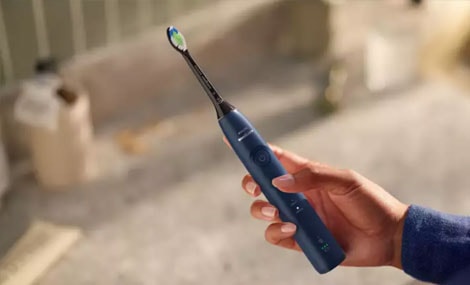
How often should you change your toothbrush?

If you've spotted a hard, white lump at the back of your throat, you might have a tonsil stone. These light-coloured lumps sit in your tonsils, poking out when they're big enough. On the whole, though, they're not anything to worry about.
But, to stop your tonsil stones from creating any bigger issues, it’s smart to learn more about them. What are tonsil stones and why do you get them? Dive into the nooks and crannies of your tonsils and get rid of those stinky stones with this detailed guide.
Medically known as tonsilloliths, tonsil stones are white or yellow calcified lumps that form in your tonsils (which lie at the back of the mouth, towards the throat, with one tonsil on each side). These little lumps tend to be around the size of a grain of rice but can break off into smaller pieces or grow larger, leading to the potential need for professional removal. Usually, though, they’ll come out by themselves or with some gentle help from a power flosser. Tonsil stones can cause a very unpleasant smell. And if you’re struggling with how to beat bad breath and no amount of brushing seems to fix the problem, it might be worth taking a look to see if you have any white lumps lurking in the back of your mouth. They could be the root cause of the smell.
If you look closely, you’ll spot that your tonsils have lots of little holes in their surface. It’s in these cavities that mucus, food, and other debris can easily become lodged.1 This doesn’t always happen (not everybody will get tonsil stones in their life) but when it does the build-up can calcify into solid stone, causing blockages in the crevices and creating hard, smelly lumps. But what causes tonsil stones in some and not others? There are certain factors that can increase your chances of getting them.2 If you’re frequently battling throat stones, it might be because you: Not sure which factor is behind your frequent occurrence of tonsil stones? When the root cause is unclear, it’s best to start by looking at your dental hygiene.
Though not typically a huge cause for concern, some symptoms are associated with tonsil stones. Bad breath is the most frequent, with the food and mucus leading to a lot of bacteria building up that can get pretty stinky! The bad bacteria can also potentially throw your oral microbiome out of balance.
Apart from bad breath, tonsil stones symptoms can also include a persistent sore throat and difficulty swallowing.2 This can feel similar to the symptoms of a cold and cause a lot of discomfort. Some people might suffer from persistent coughing and ear pain, too, making it worth seeking professional advice if you frequently struggle with tonsil stones.
Though tonsil stone symptoms aren’t necessarily a serious issue that you need to be concerned about, they can still cause discomfort. Whether you’re struggling with bad breath or a sore throat, if you’re regularly spotting those white lumps poking out of your tonsils, you’ll probably want to do something about them. Luckily, there are a few ways that you can prevent tonsil stones. The first is to double down on your dental hygiene, switching up your current routine for a more thorough, bacteria-busting clean. Make sure that you’re brushing your teeth twice a day using a good toothbrush that effectively removes bacteria and plaque, like the Philips Sonicare DiamondClean 9000. Proven to remove 10x more plaque compared to manual brushing* and with built-in sensors to improve your pressure and technique, it’s ideal for levelling up your teeth cleaning routine. You can also mix and match your brush heads for a clean that’s tailored to your needs. Aside from our Kid and One speciality ranges, all our brush heads are compatible with our brush handles. For 7x healthier gums, simply click on the G3 Premium Gum brush head. And for 100% whiter teeth, or when you need a more sensitive brush, switch to the W2 Optimal White and the S2 Sensitive brush heads, respectively. Gone are the days of not knowing when to replace your brush head. With BrushSync technology, your Sonicare DiamondClean 9000 will not only instantly recognise the new brush head, but remind you when to replace it, too.
Even with good oral hygiene, you can’t always stop those smelly lumps from forming. So, what helps with tonsil stones when they’ve already appeared? Before taking any action, it’s recommended that you seek medical attention for recurring stones. Though the tonsil stones smell is often the most annoying side effect, there are potential issues associated with your tonsils that could need professional input. After you’ve spoken to a medical professional and got the go-ahead, you can begin dealing with tonsil stones at home.Here are some quick solutions for what to do for tonsil stones: To get started with flossing, find an effective device like the Philips Power Flosser. With an ergonomic handle, it’s easy to manoeuvre to the back of your mouth, where a comfortable water pressure provides just enough force to dislodge small debris, like tonsil stones. This is also a great option for improving your oral hygiene and maintaining healthy gums, with a Deep Clean mode to target those hard-to-reach areas. For ways to get rid of tonsil stones with a power flosser, simply: In severe cases, you might see swollen, large tonsil stones. Bad breath, pain, and inflammation are all common side effects of these larger stones, and it’s a good idea to seek professional help for your problem.3 A quick surgical procedure could get rid of your tonsil stones once and for all, leading to fresher breath and a happier you.